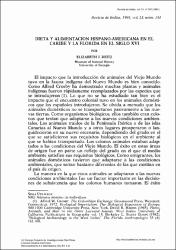Search
Now showing items 1-8 of 8
A second Anolis lizard in Dominican amber and the systematics and ecological morphology of Dominican amber anoles.
(1998)
A fossil Anolis lizard in the collections of the American Museum of Natural History is the second anole preserved in amber from the Dominican Republic (Miocene epoch) to be studied...
Tertiary fossil plants from the Dominican Republic
(1921)
During the reconnaissance of the Dominican Republic, made during 1919 under the direction of T. Wayland Vaughan for the Dominican Government, fossil plants were collected at seven different localities.
Mammals eaten by Indians, owls, and Spaniards in the coast region of the Dominican Republic (with two plates)
(1929)
In February and March, 1928, I visited the Samana Bay region, northeastern Dominican Republic with the special object of obtaining remains of mammals in the Indian deposits that had been previously examined by Gabb in ...
The origin of West Indian amphibians and reptiles
(1996)
The known West Indian herpetofauna is comprised of 175 species of amphibians (99% endemic) and 457 species of reptiles (93% endemic). Informaation on distributions, relationships, and times of origin, with emphasis on ...
Caribbean biogeography : molecular evidence for dispersal in West Indian terrestrial vertebrates
(1992)
The geological association of the Greater Antilles with North and South America in the late Cretaceous led to the hypothesis that the present Antillean biota reflects those ancient land connections. Molecular data from ...
Dieta y alimentación hispano-americana en el Caribe y la Florida en el siglo XVI
(1991)
Los esfuerzos coloniales europeos alcanzaron un mayor éxito en aquellas zonas americanas donde se arraigaron las plantas y los animales que los españoles llevaron consigo. Esta afirmación parece indicar que las plantas ...
Vicariance and dispersal in Caribbean biogeography
(1996)
The species diversity and phylogenetic relationships of West Indian vertebrates are incompletely known, but several lines of evidence support a dispersal origin for most of the fauna. Crother and Guyer have contested much ...
The extinct Cuban and Hispaniolan macaws (Ara, Psittacidae), and description of a new species, Ara cubensis
(1985)
The former existence of an extinct macaw of Hispaniola, Ara tricolor Bechstein 1811, in addition to the extinct macaw of Cuba, Ara cubensis n. sp., is demonstrated through an analysis of the literature. Ara tricolor was ...








